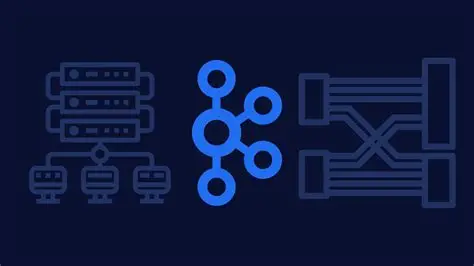在实时数据处理领域,窗口计算是解决时间维度聚合问题的关键技术。本文深入解析Kafka Streams提供的三种核心窗口类型(翻转窗口、跳跃窗口、会话窗口),通过电商大促场景下的真实案例,展示如何利用窗口技术实现实时GMV统计、用户行为分析和热门商品排行等业务需求。文章还包含窗口选择策略、性能优化技巧和进阶实现方案,帮助开发者掌握流式计算的核心能力。
一、窗口技术基础概念
在流处理中,窗口是将无限数据流划分为有限数据块的计算单元。Kafka Streams作为Apache Kafka的流处理库,提供了完善的窗口抽象能力,支持基于时间的精确聚合计算。
窗口 vs. 流处理
- 无界数据流:持续不断产生的数据,没有自然终点
- 窗口作用:为无界数据提供时间边界,使聚合计算成为可能
- 状态管理:窗口计算需要维护中间状态,Kafka Streams使用RocksDB实现高效状态存储

二、核心窗口类型详解
1. Tumbling Windows(翻转窗口)
定义与特点:
- 固定大小、完全不重叠的时间窗口
- 每个事件只能属于一个窗口
- 窗口边界严格对齐时间周期
代码示例:
// 每5分钟统计一次订单量
TimeWindows tumblingWindows = TimeWindows.of(Duration.ofMinutes(5))
.grace(Duration.ofSeconds(30)); // 允许30秒延迟数据
KStream<String, OrderEvent> orders = builder.stream("orders");
orders.groupByKey()
.windowedBy(tumblingWindows)
.count() // 统计窗口内订单数
.toStream()
.to("order-counts", Produced.with(WindowedSerdes.timeWindowedSerdeFrom(String.class), Serdes.Long()));电商应用场景:
- 实时流量统计:每5分钟统计一次网站访问量
- 批处理模拟:将流数据切分为微批次,兼容离线分析系统
对比优势:
- 计算简单高效,资源消耗低
- 结果可预测性强,适合固定周期报表
2. Hopping Windows(跳跃窗口)
定义与特点:
- 固定大小但允许重叠的窗口
- 通过advance interval控制滑动步长
- 同一事件可能属于多个窗口
代码示例:
// 每2分钟计算过去10分钟的用户点击量
TimeWindows hoppingWindows = TimeWindows.of(Duration.ofMinutes(10))
.advanceBy(Duration.ofMinutes(2)) // 每2分钟滑动一次
.grace(Duration.ofSeconds(10));
orders.groupByKey()
.windowedBy(hoppingWindows)
.aggregate(
() -> 0L, // 初始值
(key, value, aggregate) -> aggregate + 1, // 累加器
Materialized.<String, Long, WindowStore<Bytes, byte[]>>as("click-count-store")
.withKeySerde(Serdes.String())
.withValueSerde(Serdes.Long())
)
.toStream()
.map((windowedKey, count) -> new KeyValue<>(windowedKey.key(), count))
.to("click-rate", Produced.with(Serdes.String(), Serdes.Long()));电商应用场景:
- 移动平均计算:实现平滑的趋势分析
- 异常检测:捕捉瞬时流量峰值
对比优势:
- 计算结果更平滑,减少数据波动
- 支持更细粒度的时间维度分析
3. Session Windows(会话窗口)
定义与特点:
- 动态窗口,由事件活跃间隙分割
- 通过inactivity gap参数控制窗口关闭
- 窗口大小不固定,完全由数据驱动
代码示例:
// 30分钟无操作视为会话结束
SessionWindows sessionWindows = SessionWindows.with(Duration.ofMinutes(30));
orders.groupByKey()
.windowedBy(sessionWindows)
.aggregate(
() -> new UserSession(), // 初始会话对象
(key, value, aggregate) -> aggregate.addEvent(value), // 累加事件
(key, firstAggregate, secondAggregate) -> firstAggregate.merge(secondAggregate), // 合并会话
Materialized.<String, UserSession, SessionStore<Bytes, byte[]>>as("user-session-store")
.withKeySerde(Serdes.String())
.withValueSerde(new JsonSerde<>(UserSession.class))
)
.toStream()
.map((windowedKey, session) -> {
// 计算会话指标
SessionMetrics metrics = calculateMetrics(session);
return new KeyValue<>(windowedKey.key(), metrics);
})
.to("user-sessions", Produced.with(Serdes.String(), new JsonSerde<>(SessionMetrics.class)));电商应用场景:
- 用户购物车放弃分析
- 游戏玩家行为分析
- 单次会话转化率计算
对比优势:
- 完美适配用户行为分析场景
- 自动适应数据分布特征
三、电商实战案例深度解析
案例1:实时GMV统计系统
业务需求:
- 每5分钟统计全平台交易额
- 支持延迟数据补录
- 结果写入时序数据库供Dashboard展示
实现方案:
// 定义带grace period的翻转窗口
TimeWindows gmwWindows = TimeWindows.of(Duration.ofMinutes(5))
.grace(Duration.ofSeconds(30));
// 按商品ID分组,计算窗口内销售额
KStream<String, OrderEvent> orders = builder.stream("orders");
orders.filter((key, value) -> value.getType() == OrderType.PURCHASE)
.mapValues(value -> value.getAmount()) // 提取金额
.groupByKey()
.windowedBy(gmwWindows)
.reduce(
(v1, v2) -> v1 + v2, // 金额累加
Materialized.<String, Double, WindowStore<Bytes, byte[]>>as("gmv-store")
.withKeySerde(Serdes.String())
.withValueSerde(Serdes.Double())
)
.toStream()
.map((windowedKey, amount) -> {
// 格式化输出
String windowStart = Instant.ofEpochMilli(windowedKey.window().start())
.atZone(ZoneId.systemDefault()).toString();
return new KeyValue<>(windowStart, amount);
})
.to("gmv-metrics", Produced.with(Serdes.String(), Serdes.Double()));优化技巧:
- 使用
grace period处理支付延迟 - 按商品ID分组实现多维分析
- 结果写入时序数据库支持趋势查询
案例2:用户购物车放弃分析
业务需求:
- 检测添加商品到购物车但未支付的用户行为
- 计算不同时间段的放弃率
- 识别高放弃率商品品类
实现方案:
// 定义30分钟会话窗口
SessionWindows cartWindows = SessionWindows.with(Duration.ofMinutes(30));
// 跟踪购物车事件序列
KStream<String, CartEvent> cartEvents = builder.stream("cart-events");
cartEvents.groupByKey()
.windowedBy(cartWindows)
.aggregate(
() -> new CartSession(), // 初始会话状态
(userId, event, session) -> session.processEvent(event),
Materialized.<String, CartSession, SessionStore<Bytes, byte[]>>as("cart-session-store")
.withKeySerde(Serdes.String())
.withValueSerde(new JsonSerde<>(CartSession.class))
)
.toStream()
.filter((windowedKey, session) -> session.isAbandoned()) // 过滤放弃会话
.map((windowedKey, session) -> {
// 生成放弃事件
AbandonEvent event = new AbandonEvent(
windowedKey.key(),
session.getCartItems(),
Duration.between(
Instant.ofEpochMilli(windowedKey.window().start()),
Instant.ofEpochMilli(windowedKey.window().end())
)
);
return new KeyValue<>(windowedKey.key(), event);
})
.to("cart-abandons", Produced.with(Serdes.String(), new JsonSerde<>(AbandonEvent.class)));分析维度:
- 按时间段统计放弃率
- 按商品品类分析放弃原因
- 结合用户画像识别高价值流失用户
案例3:热门商品实时排行
业务需求:
- 每分钟更新一次热门商品排行
- 统计过去15分钟的点击量
- 支持窗口滑动更新
实现方案:
// 定义15分钟跳跃窗口,每分钟滑动一次
TimeWindows trendingWindows = TimeWindows.of(Duration.ofMinutes(15))
.advanceBy(Duration.ofMinutes(1))
.grace(Duration.ofSeconds(5));
// 按商品ID统计点击量
KStream<String, ClickEvent> clicks = builder.stream("click-events");
clicks.groupByKey()
.windowedBy(trendingWindows)
.count(Materialized.<String, Long, WindowStore<Bytes, byte[]>>as("click-count-store"))
.toStream()
.map((windowedKey, count) -> {
// 提取窗口结束时间作为排行时间点
long windowEnd = windowedKey.window().end();
return new KeyValue<>(windowEnd, new ProductCount(windowedKey.key(), count));
})
.groupByKey()
.aggregate(
() -> new ProductRanking(), // 初始排行状态
(timestamp, productCount, ranking) -> ranking.update(productCount),
Materialized.<Long, ProductRanking, KeyValueStore<Bytes, byte[]>>as("product-ranking-store")
)
.toStream()
.map((timestamp, ranking) -> {
// 生成排行结果
List<ProductCount> topProducts = ranking.getTopN(10);
return new KeyValue<>(timestamp, topProducts);
})
.to("product-rankings", Produced.with(Serdes.Long(), new JsonSerde<>(List.class)));性能优化:
- 使用本地状态存储减少网络IO
- 设置合理的retention period控制存储增长
- 结果预聚合减少下游处理压力
四、窗口技术深度对比
| 特性维度 | 翻转窗口 | 跳跃窗口 | 会话窗口 |
|---|---|---|---|
| 窗口大小 | 固定 | 固定 | 动态 |
| 窗口重叠 | 不重叠 | 允许重叠 | 完全动态 |
| 计算复杂度 | 低 | 中 | 高 |
| 适用场景 | 固定周期统计 | 趋势分析/异常检测 | 用户行为分析 |
| 状态管理 | 简单 | 中等 | 复杂 |
| 结果确定性 | 高 | 中 | 低 |
选择建议:
- 数据分布均匀 → 翻转窗口
- 需要平滑计算 → 跳跃窗口
- 用户行为分析 → 会话窗口
- 混合场景 → 组合使用多种窗口
五、性能优化与容错实践
1. 状态存储调优
// 配置RocksDB压缩选项
Materialized.as("window-store")
.withCachingEnabled()
.withLoggingEnabled(Collections.singletonMap("compression.type", "lz4"))优化措施:
- 启用RocksDB块缓存
- 配置压缩算法减少存储空间
- 设置合理的缓存大小
2. 容错配置
// 启用精确一次处理语义
props.put(StreamsConfig.PROCESSING_GUARANTEE_CONFIG, "exactly_once_v2");
// 监控延迟指标
Metrics.addMetric("late-records-dropped",
(config, now) -> streams.metrics().metrics().get("dropped-records-total").metricValue());最佳实践:
- 生产环境务必启用
exactly_once语义 - 监控
num.late.records.dropped指标 - 根据业务特点设置合理的grace period
六、进阶应用模式
1. 动态窗口实现
通过自定义WindowStore实现基于业务规则的窗口分割:
// 示例:基于订单状态的动态窗口
public class OrderStateWindow extends AbstractWindow {
// 实现自定义窗口逻辑
}2. 窗口联结分析
结合多个窗口的结果进行跨维度分析:
// 当前窗口与历史同期对比
KStream<String, CurrentStats> current = ...;
KStream<String, HistoricalStats> historical = ...;
current.join(historical,
(curr, hist) -> new ComparisonResult(curr, hist),
JoinWindows.of(Duration.ofHours(1)),
StreamJoined.with(Serdes.String(), new JsonSerde<>(CurrentStats.class), new JsonSerde<>(HistoricalStats.class))
)总结
Kafka Streams的窗口技术为实时数据处理提供了强大的时间维度聚合能力。本文通过电商场景的三个典型应用案例,详细展示了:
- 翻转窗口在固定周期统计中的高效应用
- 跳跃窗口在趋势分析和异常检测中的优势
- 会话窗口在用户行为分析中的不可替代性
关键收获:
- 理解不同窗口类型的核心特点和适用场景
- 掌握电商实时分析的典型实现模式
- 学习性能优化和容错配置的实用技巧
窗口技术正在成为实时计算领域的基础设施,熟练掌握这些技能将帮助开发者构建更强大的流处理应用。未来随着Kafka生态的演进,窗口计算能力还将持续增强,值得持续关注和学习。